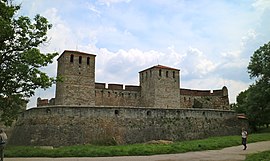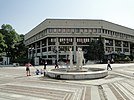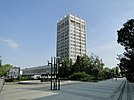Vidin
Vidin
Видин (Bulgarian) | |
|---|---|
Vidin | |
|
UTC+3 (EEST) | |
| Postal Code | 3700 |
| Area code | 094 |
| Website | https://vidin.bg/?lang=en |
 | |
Vidin (Bulgarian: Видин, pronounced [ˈvidin]) is a port city on the southern bank of the Danube in north-western Bulgaria. It is close to the borders with Romania and Serbia, and is also the administrative centre of Vidin Province, as well as of the Metropolitan of Vidin (since 870).
An industrial, agricultural and trade centre, Vidin has a fertile hinterland renowned for its wines.
Name
The name is archaically spelled as Widdin in English. Its older form Dunonia meant "fortified hill" in Celtic with the dun element found frequently in Celtic place names.[2] It is known as Diiu in Romanian.
Geography
Vidin is the westernmost important Bulgarian Danube port and is situated on one of the southernmost sections of the river. The New Europe Bridge, completed in 2013, connects Vidin to the Romanian town of Calafat on the opposite bank of the Danube. Previously, a ferry located 2 km (1 mi) from the town was in use for that purpose.
History
Vidin emerged at the place of an old Celtic settlement known as Dunonia.
The
Middle Ages

When
By early 1290s the
Hungarian occupation of Vidin
In 1365, the
Ottoman rule
The Ottomans went on to conquer the
The city fell under Austrian occupation in October 1689 during the Great Turkish War. Both Austrians and the Ottomans had heavy casualities during the siege. The occupation lasted nine months and ended in August 1690. Shortly after Vidin's capture, in 19 October 1689 2.500 Muslim men and 1,000 Muslim women from Vidin were deported to Nikopol. The Austrians also built a military facility in front of the Vidin citadel, where they placed more than 40 cannons. During the construction, a large number of Muslim houses and shops were destroyed. Of 3,000 buildings, two hammams, many mosques, shops and coffee shops only 200-300 buildings and several shops survived.[6]
In the late years of
In 1853, The Times of London reported that Widdin, as it was called, was
a considerable town, with a population of about 26,000, and a garrison of 8,000 to 10,000 men. Widdin is one of the important fortified places of the military line of the Danube. It covers the approaches of
In 1859 the English traveler Samuel Baker happened to visit Vidin and spotted the 14-year old Florence Barbara Maria von Sass from Transylvania (then in Hungary now in Romania) being sold into slavery, by some accounts destined to be owned by the Pasha of Vidin. Baker bribed her guards and took her with him, she eventually became Florence Baker, his wife and partner in the exploration of Africa .[8][5]
Some Muslims from Belgrade, Kladovo, and Smederevo settled in Vidin due to their expulsion from Serbia in 1862.[9]
Third Bulgarian State
After the Liberation of Bulgaria in 1878 Vidin was included in the reestablished Bulgarian state, the Principality of Bulgaria. The city was unsuccessfully besieged by the Serbian army during the Serbo-Bulgarian War in 1885 and the Second Balkan War in 1913.
Population
| Year | Pop. | ±% |
|---|---|---|
| 1946 | 18,481 | — |
| 1956 | 23,932 | +29.5% |
| 1965 | 36,835 | +53.9% |
| 1975 | 53,091 | +44.1% |
| 1985 | 62,693 | +18.1% |
| 1992 | 62,691 | −0.0% |
| 2001 | 57,395 | −8.4% |
| 2011 | 48,071 | −16.2% |
| 2021 | 35,784 | −25.6% |
| Source: pop-stat.mashke.org[10] | ||
Vidin is the 20th town by population in Bulgaria, but serious demographic problems have been experienced in the area during the last two decades. The number of the residents of the city reached its peak between 1988 and 1991 when the population exceeded 65,000.[11] As of 2011, the town had a population of 48,071 inhabitants[12] and 35,784 inhabitants as of 2021.
Ethnic, linguistic and religious composition
According to the latest 2011 census data, the individuals declared their ethnic identity were distributed as follows:[13][14]
- Bulgarians: 40,550 (91.8%)
- Roma: 3,335 (7.5%)
- Turks: 60 (0.1%)
- Others: 199 (0.4%)
- Indefinable: 280 (0.6%)
- Undeclared: 3,647 (7.6%)
Total: 48,071
Climate
Vidin has a
| Climate data for Vidin, Bulgaria (1991-2020) | |||||||||||||
|---|---|---|---|---|---|---|---|---|---|---|---|---|---|
| Month | Jan | Feb | Mar | Apr | May | Jun | Jul | Aug | Sep | Oct | Nov | Dec | Year |
| Record high °C (°F) | 21.7 (71.1) |
24.4 (75.9) |
28.0 (82.4) |
32.4 (90.3) |
35.4 (95.7) |
41.2 (106.2) |
43.6 (110.5) |
40.2 (104.4) |
36.4 (97.5) |
31.2 (88.2) |
26.4 (79.5) |
21.4 (70.5) |
43.6 (110.5) |
| Mean daily maximum °C (°F) | 4.4 (39.9) |
7.2 (45.0) |
13.3 (55.9) |
19.2 (66.6) |
24.4 (75.9) |
28.6 (83.5) |
30.9 (87.6) |
31.0 (87.8) |
25.2 (77.4) |
18.2 (64.8) |
10.4 (50.7) |
5.0 (41.0) |
18.2 (64.7) |
| Daily mean °C (°F) | −0.2 (31.6) |
1.7 (35.1) |
6.6 (43.9) |
12.4 (54.3) |
17.7 (63.9) |
21.8 (71.2) |
23.7 (74.7) |
23.0 (73.4) |
17.4 (63.3) |
11.4 (52.5) |
5.7 (42.3) |
0.8 (33.4) |
11.8 (53.3) |
| Mean daily minimum °C (°F) | −3.9 (25.0) |
−2.6 (27.3) |
1.3 (34.3) |
5.8 (42.4) |
11.1 (52.0) |
14.8 (58.6) |
16.4 (61.5) |
15.9 (60.6) |
11.5 (52.7) |
6.5 (43.7) |
2.0 (35.6) |
−2.7 (27.1) |
6.3 (43.4) |
| Record low °C (°F) | −24.0 (−11.2) |
−28.6 (−19.5) |
−13.6 (7.5) |
−5.0 (23.0) |
−0.4 (31.3) |
2.8 (37.0) |
9.2 (48.6) |
7.0 (44.6) |
−1.2 (29.8) |
−6.6 (20.1) |
−16.4 (2.5) |
−21.4 (−6.5) |
−28.6 (−19.5) |
| Average precipitation mm (inches) | 41 (1.6) |
40 (1.6) |
43 (1.7) |
44 (1.7) |
56 (2.2) |
51 (2.0) |
55 (2.2) |
44 (1.7) |
44 (1.7) |
51 (2.0) |
46 (1.8) |
50 (2.0) |
565 (22.2) |
| Average precipitation days (≥ 1.0mm) | 6 | 6 | 6 | 7 | 8 | 6 | 6 | 4 | 6 | 7 | 7 | 7 | 76 |
| Mean monthly sunshine hours | 82 | 112 | 168 | 209 | 256 | 292 | 325 | 306 | 218 | 153 | 79 | 69 | 2,269 |
| Source: NOAA NCEI[15] | |||||||||||||
Tourism
Another tourist attraction in the Vidin area is the town of Belogradchik, famous for its unique and impressive rock formations, the Belogradchik Rocks and the medieval Belogradchik Fortress and also the nearby Magura Cave with its beautiful prehistoric cave paintings.
Archaeology
A fragmented marble structure found near Vidin shows a bearded man in a



















